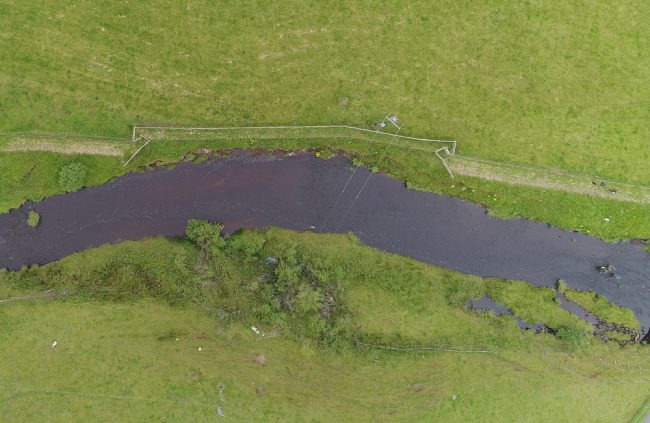The rain held off last night and we decided to head to the top of the River Ayr and work downstream as we undertook the timed surveys of the Ayr today. Water levels were still dropping so we figured starting at the top of the catchment would work best.

The team electrofishing downstream of the Ponesk confluence on the upper Ayr
Results at the top of the river were consistent with last year although that is slightly disappointing considering the quality of the substrates. Conductivity was typically high and a sign that mine pollution continues to affect the upper river in this area. None the less, there were salmon and although not as high as we’ve found just a few years ago, they were there in good numbers. There are major works underway to restore Spireslack Opencast on the Ponesk and while it won’t ever be the same again, it will be better to see the land restored to something more appealing than bare rock piles and spoil heaps.

Still a fair bit of work to do but already this restoration makes the landscape much more appealing than what was there a year ago
Downstream at Nether Welwood where the Powharnol OCCSite is also being restored, the numbers were up on last year so that was encouraging.

Restoration of Powharnol surface mine is also well underway

A sample of juvenile fish from the Nether Wellwood site
The erosion on the right bank that washed away the River Ayr Walk continues and we will soon attempt to run a volunteer day to stabilse this section (let us know if you can help).

The River Ayr way on the north bank had to be re routed as the bank collapse took the original path away. This section could easily be stabilise by green engineering as we have done elsewhere and the Trust hopes to deliver this work to demonstrate to local landowners and anglers, what may be achieved easily with local and often free materials.
Continuing downstream, Limmerhaugh was excellent with a fantastic number of fry captured much to the surprise of Knut (a volunteer for the day) who has never seen as many salmon in one place before. These result here was better than we’ve seen for several years. and may be linked to increased numbers of salmon reaching spawning time. This is exactly what the conservation measures that were in force last year were meant to achieve but can we attribute this solely to catch and release? We will never be certain of the answer to that question but I can’t help but suspect there more than a little coincidence.

An encouraging sample form Limmerhaugh
The next site was at Glen Logan where we’ve never really ever had results worth writing home about but today was different. This site hardly had any juvenile salmon for the last few years yet today, it burst with fish and produced our best result at this location since we started surveying it in 2009.
Catrine, beside the bonded warehouse was the next stop and it too was productive and encouraging.


